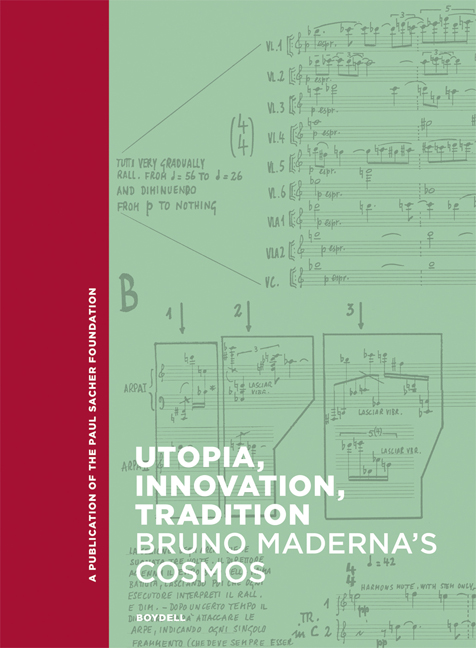Book contents
- Frontmatter
- Contents
- INTRODUCTION
- STAGING AND PERFORMING SOUNDS: A GLANCE THROUGH THE LAST THEATRICAL WORK
- BUILDING SOUNDS: THE COMPOSER
- CREATING SOUND: THE MUSIC BEYOND/WITHOUT THE STAGE
- REINVENTING SOUNDS: DIALOGUES WITH MUSIC OF EVERY EPOCH AND STYLE
- ACROSS BORDERS: THE CONDUCTOR AND THE INTERPRETER
- SEARCHING FOR ROOTS: THE DEVELOPMENT OF A STYLE
- STAGING AND PERFORMING TEXTS: A GLANCE THROUGH EARLY DRAMATURGICAL AND VOCAL WORKS
- Chronology Of Bruno Maderna’s Works
- Selected Bibliography
- Index
The Unity of Musical Practice: Bruno Maderna and His “Shaping Form” as Composer and Performer of Experimental Orchestral Music
Published online by Cambridge University Press: 17 January 2024
- Frontmatter
- Contents
- INTRODUCTION
- STAGING AND PERFORMING SOUNDS: A GLANCE THROUGH THE LAST THEATRICAL WORK
- BUILDING SOUNDS: THE COMPOSER
- CREATING SOUND: THE MUSIC BEYOND/WITHOUT THE STAGE
- REINVENTING SOUNDS: DIALOGUES WITH MUSIC OF EVERY EPOCH AND STYLE
- ACROSS BORDERS: THE CONDUCTOR AND THE INTERPRETER
- SEARCHING FOR ROOTS: THE DEVELOPMENT OF A STYLE
- STAGING AND PERFORMING TEXTS: A GLANCE THROUGH EARLY DRAMATURGICAL AND VOCAL WORKS
- Chronology Of Bruno Maderna’s Works
- Selected Bibliography
- Index
Summary
One essential aspect of European post-WWII serialism was the postulate of the reciprocal conditioning of material and form, that is to say, the privileged relation between micro- and macrostructure. This interaction between the different levels of musical structure also directed composers to use studio facilities in synthetic sound production, since these devices seemed to offer them the means to structurally inform sound from the inside, to “compose” it in the most emphatic sense of the word, according to the same determinations as the other acoustic dimensions and further aspects of the music. Among the instrumental scores displaying an almost literal correspondence between the micro- and macrolevels, one of the earliest examples is John Cage's First Construction in Metal (1939), where this reciprocity determines the relation between the inner articulation of the first unit of sixteen bars and the whole form of 16 × 16 bars. This model helped Pierre Boulez to complete his strategies of integral serial composition as realized in his Structure Ia (1951), where the intervals within the series are projected onto the level of the series’ transpositions (including furthermore a principle of inversion responsible for the linking of the different levels of the structuration). In Karlheinz Stockhausen's Studie I (1953), the first electronic music realized by superimposed sine waves in an effort to “compose timbre,” the proportion series organizes all the levels, from the number of components per sound and the number of sounds per structure up to the number of sections within the piece. Considering the serial repertoire of the 1950s globally, such linear implications from the basic material to the formal development are typical of the initial attempts, and there exist, according to present knowledge, only a few later examples supporting the idea of an almost “algorithmic” strategy. Indeed, in most cases, supplementary decisions were taken that disrupt any kind of linearity between the levels. Nevertheless, such decisions do not suspend the general idea of reciprocity, since the procedures at the different levels act according to similar strategies, which seemed, for many of these composers, sufficient to ensure coherence. Let us consider a few examples within the mature serial style, addressing either the possible margin of independent decisions or the presence of micro/macro relations even in aleatoric works, as well as the gap between theoretical formulations by composers and the proper reality in the composed music.
- Type
- Chapter
- Information
- Utopia, Innovation, TraditionBruno Maderna's Cosmos, pp. 115 - 138Publisher: Boydell & BrewerPrint publication year: 2023

